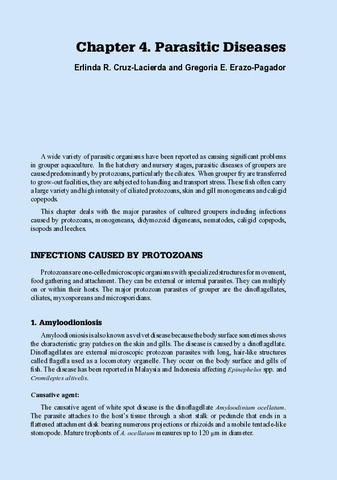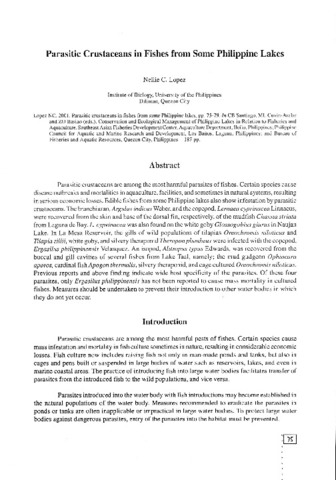Establishment and application of prevention and control methods against parasites of fish cultured in the Philippines
| dc.contributor.author | Cruz-Lacierda, Erlinda R. | |
| dc.contributor.author | Pineda, April Joy T. | |
| dc.contributor.editor | Nagasawa, Kazuya | |
| dc.date.accessioned | 2020-07-23T00:33:22Z | |
| dc.date.available | 2020-07-23T00:33:22Z | |
| dc.date.issued | 2005-03 | |
| dc.identifier.citation | Cruz-Lacierda, E. R., & Pineda, A. J. T. (2005). Establishment and application of prevention and control methods against parasites of fish cultured in the Philippines. In K. Nagasawa (Ed.), Recent Advances in Diagnosis and Prevention of Fish and Shrimp Diseases in Southeast Asia (pp. 315–325). Tigbauan, Iloilo, Philippines: Aquaculture Department, Southeast Asian Fisheries Development Center. | en |
| dc.identifier.isbn | 9718511732 | |
| dc.identifier.uri | http://hdl.handle.net/10862/5937 | |
| dc.description.abstract | The efficacy of bath treatment methods against the ectoparasites Amyloodinium ocellatum, Pseudorhabdosynochus lantauensis and Zeylanicobdella arugamensis on marine fish was determined under laboratory conditions. The toxicity of formalin and hydrogen peroxide (H2O2) to orange-spotted grouper (Epinephelus coioides) were also investigated. Freshwater or 200 ppm H2O2 bath treatments for 1 hr were effective against the dinoflagellate A. ocellatum on hatchery-reared mangrove red snapper (Lutjanus argentimaculatus). Hydrogen peroxide at 200 ppm for 1 hr was effective in eliminating the gill monogenan P. lantauensis on E. coioides fingerlings. In vitro treatments of the marine leech Z. arugamensis using 250 ppm formalin for 3 hr significantly killed the parasite. Chlorine at 50 ppm for 1 hr can be used to disinfect leech-contaminated facilities. The computed 3 hr and 6 hr LC10 (10% lethal concentration) of formalin to E. coioides fingerlings is 322 ppm and 275 ppm, respectively, at 28°C. The 9 hr LC10 and LC50 (median lethal concentration) of H2O2 to grouper are 255 and 298 ppm at 28°C. | en |
| dc.language.iso | en | en |
| dc.publisher | Aquaculture Department, Southeast Asian Fisheries Development Center | en |
| dc.subject | Amyloodinium ocellatum | en |
| dc.subject | groupers | en |
| dc.subject | Epinephelus coioides | en |
| dc.subject | snappers | en |
| dc.subject | Lutjanus argentimaculatus | en |
| dc.subject | Philippines | en |
| dc.title | Establishment and application of prevention and control methods against parasites of fish cultured in the Philippines | en |
| dc.type | Book chapter | en |
| dc.citation.spage | 315 | en |
| dc.citation.epage | 325 | en |
| dc.citation.bookTitle | Recent Advances in Diagnosis and Prevention of Fish and Shrimp Diseases in Southeast Asia | en |
| dc.subject.asfa | parasite control | en |
| dc.subject.asfa | fish culture | en |
| dc.subject.asfa | parasites | en |
| dc.subject.asfa | aquaculture systems | en |
| dc.subject.asfa | tolerance | en |
| dc.subject.asfa | bio-assays | en |
| dc.subject.asfa | fish diseases | en |
| dc.subject.scientificName | Pseudorhabdosynochus lantauensis | en |
| dc.subject.scientificName | Zeylanicobdella arugamensis | en |
このアイテムのファイル
このアイテムは次のコレクションに所属しています
-
Recent Advances in Diagnosis and Prevention of Fish and Shrimp Diseases in Southeast Asia [43]
Terminal Report of the Regional Fish Disease Project on “Development of Fish Disease Inspection Methodologies for Artificially-Bred Seeds” Funded by the Government of Japan Trust Fund from 2000 to 2004


 AQD Access only
AQD Access only


